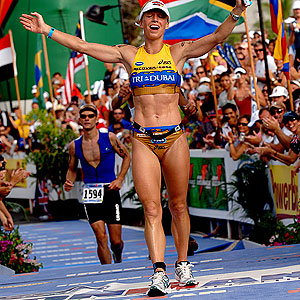
This week we're debuting some workout plans, and in devising these plans it's helpful to start at the race and march backward in time. If you approach your training in this way you can make sure you don't start your campaign for your "A" race too late... or too early.
It's been my experience that most of your training doesn't have, as its goal, preparing you for your race. Rather, it's preparing you for another set of workouts. Which prepare you for yet another set. When does that end? When are the workouts actually geared toward preparing you for the race? The answer: just before your taper.
Let me map it out for you. Let's say you're preparing for an Ironman. What happens immediately before your race? What's that phase? It's the taper. How long are we talking? That's debatable. I subscribe to the 3-week taper. This alone is worthy of its own treatise. It's not that I think no work is done during the taper, in fact I'd like to see a long run or two take place during the first of those three weeks. But the point of this 3-week period, its theme, is recovery.
Just before the taper are your most important workouts, and I call them "indicator" workouts. Others may call them by another name, but these are the workouts that prove to you that you're ready for the race. They might be longer or harder than any individual leg of the race. It's not rare for a pro to engage in a 120 or 130-mile ride, for example. That's a bit long for an AGer, but you see the point. A pro wants to be 80 or 90 miles into a hard Ironman ride knowing he's been here before, indeed he's done longer, harder rides in training.
Likewise, an 18- to 30-mile run, slow, in a forest, that takes longer (timewise) to complete than your Ironman marathon, that's the sort of workout that indicates you're ready for your race.
These workouts are not mandatory for an Ironman, but a lot of athletes engage in them. I remember many years ago calling Kenny Glah three weeks before Kona, and he'd just gotten in from a 130-mile bike ride followed by a 17-mile run. This was his indicator workout (on the hard edge of what an athlete—even a pro—might do).
I didn't ask him, but I'll bet Kenny had this workout in mind for many weeks, and that the workouts he did prior to this were not pointing for Kona per se, but were pointing toward this workout.
Two weeks, plus or minus, prior to this sort of indicator workout were rides and runs preparing for it. What were those workouts? 100-mile rides? 12- and 15-mile runs? Probably.
And prior to that? Probably an easy week. You don't make progress in a straight line, you make it in steps, followed by plateaus. It's the easy weeks, maybe one out of every four, that allow you to absorb the work and make the jumps.
The few weeks prior to that consisted of weeks getting you ready for those subsequent weeks of workouts. Perhaps these weeks alternated heavy run mileage with heavy cycling mileage. These prepare an athlete for the yet heavier miles on the road to peak fitness.
As of this writing, Ironman Wisconsin is about 9 weeks away. Assuming you're pretty fit when you start your Ironman-specific training, this is a nice interval of time for a campaign to take place. Shorter than this, it's hard for enough work to absorb to get you to your indicator workouts fit and ready. But 9 weeks gives you just enough time.
Ironman Arizona, on the other hand, at 18 weeks away, that's a bit long to start a campaign proper, unless there's a several-week break in the middle. Certainly, general triathlon training is to be engaged in, but the formal run-up to an Ironman can't take too long or else you'll reach your peak and go over the other side. How many athletes complain that it's two weeks to their Ironman and they're beat, they have no motivation, they don't really feel like doing the race? Very likely it's because they started their training too many weeks out.
How do you know how much time from the race itself should you start your formal Ironman training? Work backward from the race. What's your taper length? What are your indicator workouts? What are the two or three weeks of workouts that get you ready for that set of workouts? Plan those out, put them on your schedule. Put an easy week just before those. Then, what workouts get you ready for that set of workouts? Plan three weeks of those out. Then, place an easy week in there. And so on.
The length of your campaign depends on how well and quickly you respond to training, and your base fitness level when you start training. Just know that you've got probably 12 weeks in you at best before you need to throttle back. Once you do throttle back, you'll need an easy three to six weeks to absorb everything you did.
So, if you're signed up for Wisconsin, you can start your campaign now if you have reasonable fitness. If you're signed up for Arizona, it's fine to start a campaign now, but not the Arizona campaign. Maybe a 70.3 in a month and a half is a good intermediate goal, followed by three easy weeks. Then start your run-up to Arizona.
But you see the pattern, right? You'll know what to do, and when to do it, if you plan your campaign from your A race backward.


